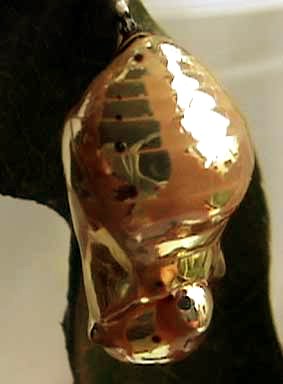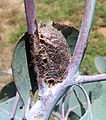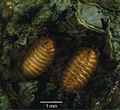Chrysalis facts for kids

A chrysalis is the special home a butterfly caterpillar builds for itself when it's ready to change into an adult butterfly. It's like a protective case where an amazing transformation, called metamorphosis, happens. The word chrysalis comes from an old Greek word meaning "gold." This is because many butterfly chrysalises have shiny, golden, or metallic spots, making them look quite beautiful!
Contents
The Amazing Butterfly Life Cycle
Butterflies go through four main stages in their lives. This process is called metamorphosis, which means a big change. Each stage is important for the butterfly to grow and develop.
From Egg to Caterpillar
It all starts when an adult butterfly lays a tiny egg, usually on a plant. After a few days, a small caterpillar (which is the larva stage) hatches from the egg. The caterpillar's main job is to eat and grow! It eats a lot of leaves and sheds its skin several times as it gets bigger.
The Chrysalis Stage
Once the caterpillar is fully grown, it stops eating. It then finds a safe spot, often hanging upside down from a twig or leaf. The caterpillar sheds its skin one last time, but instead of growing bigger, its new skin hardens into a tough, protective shell. This shell is the chrysalis. Inside this quiet case, the caterpillar doesn't just rest; it completely changes! Its body breaks down and rebuilds into the parts of an adult butterfly.
Becoming a Butterfly
After a period of time, which can be a few weeks or even months, the chrysalis becomes clear. You might even see the butterfly's wings inside! Finally, the chrysalis splits open, and a beautiful adult butterfly emerges. It will then rest for a while, pumping fluid into its wings to make them strong, before flying off to find food and lay its own eggs.
Chrysalis vs. Cocoon: What's the Difference?
It's easy to get chrysalises and cocoons mixed up, but they are different!
- A chrysalis is the pupa of a butterfly. It's a hard, smooth case made from the caterpillar's own skin. Butterflies do not spin silk to make their chrysalis.
- A cocoon is the pupa of a moth. Moths spin a silk covering around themselves to form their cocoon. This silk can be soft, tough, or even mixed with leaves and dirt.
So, if you see a hard, smooth case, it's probably a butterfly chrysalis. If it's made of silk, it's likely a moth cocoon!
Where Do Chrysalises Form?
Butterfly caterpillars are very clever about where they form their chrysalises. They need a safe place to transform without being disturbed. Many caterpillars hang upside down from a twig, a leaf, or even a fence. They attach themselves with a small silk pad and a special hook-like structure at their tail end. Some chrysalises might be hidden among leaves or even buried slightly in the ground, depending on the butterfly species.
How Long Does it Take?
The time a butterfly spends inside its chrysalis can vary a lot. For many common butterflies, it might only be about two to three weeks. However, some butterflies can stay in their chrysalis for several months, especially if they need to survive cold winter weather. They wait until the conditions are just right for them to emerge as an adult butterfly.
Images for kids
-
The tough brown cocoon of an emperor gum moth
-
Fruit fly (Drosophila melanogaster) pupa
-
An emperor gum moth caterpillar spinning its cocoon
-
Luna moth cocoon and pupa
-
Luna moth emerging from pupa within silk cocoon
-
Chrysalis of Gulf fritillary
-
Pupae of Japanagromyza inferna, a gall fly, in gall of Centrosema virginianum
-
Pupa of cabbage looper















